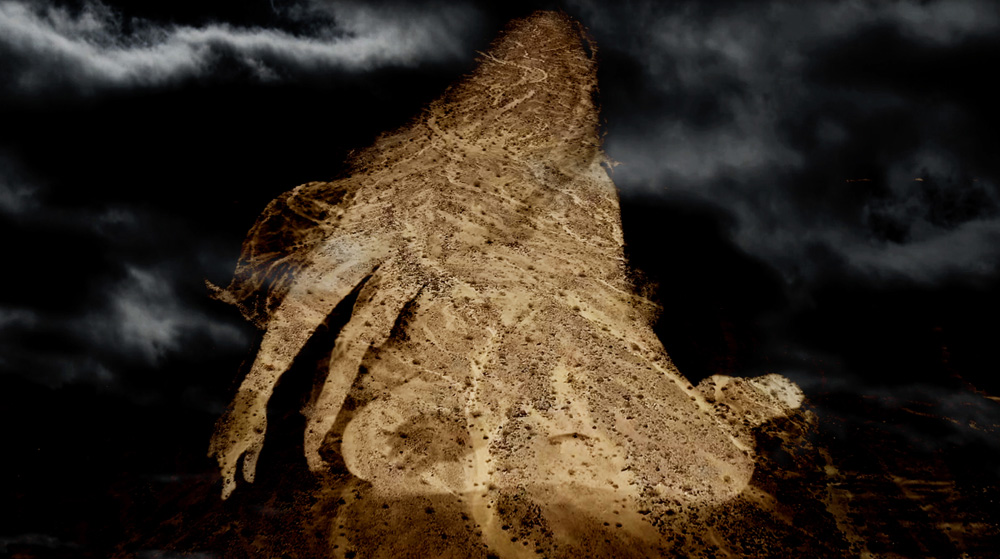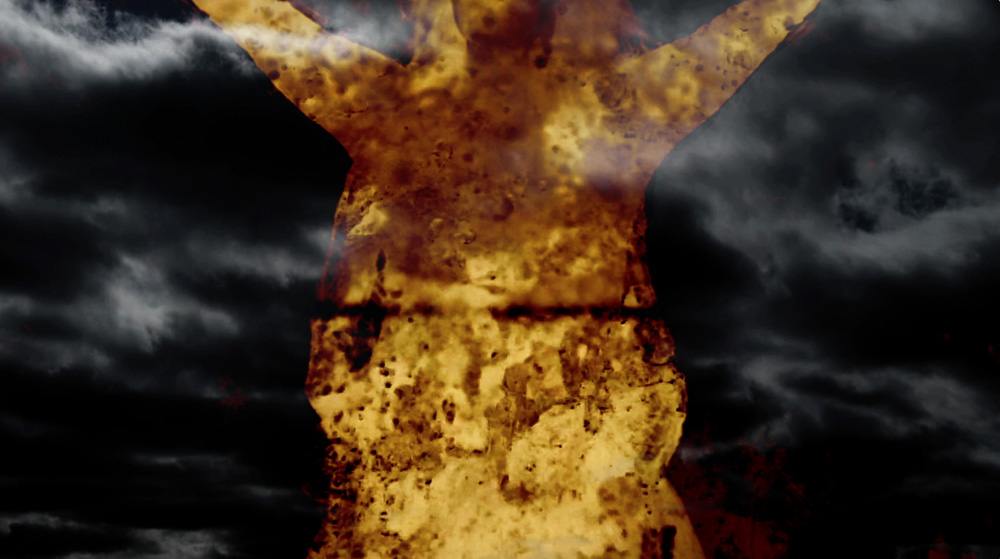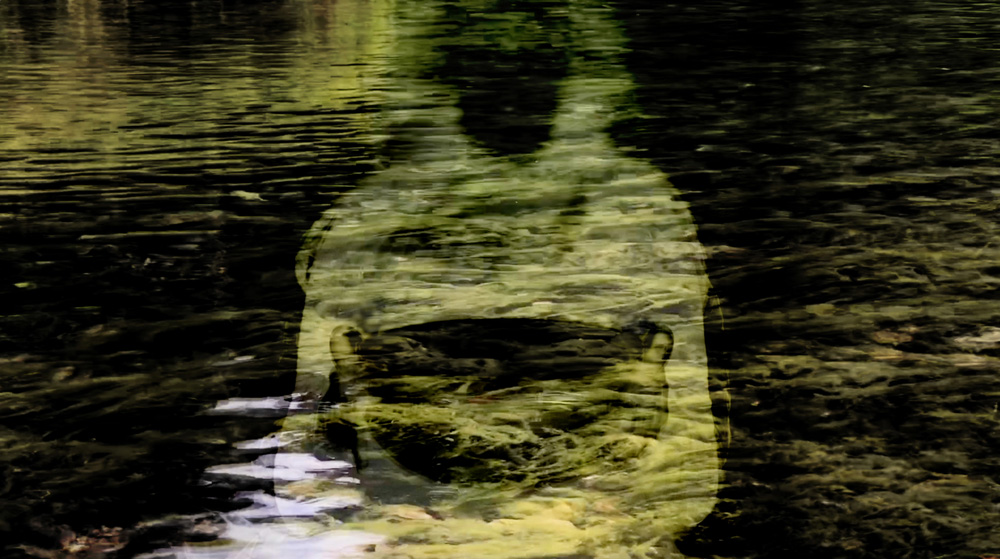Review – Živa (The Death of the Goddess Živa)
Liquid Eco-Aisthēsis: Elemental Sensorium and Femininity in Živa
Essay by Maja Manojlovic
Živa (2022), a short experimental film by Nataša Prosenc Stearns, unfolds in nine scenes, each characterized by the prominence of one of the natural elements. However, just as our planet and bodies are primarily composed of water, so does its liquid, wavy fluidity comprise this film’s images. While fluid aesthetic might be Prosenc Stearns’ signature expressive tool that defines all of her work, Živa represents the culmination of its purposeful application through what I characterize as liquid eco- aisthēsis. Eco-aisthēsis describes ecologically-accented sensory experiences that both expand and modify our senses and perceptual field. Experiences of eco-aisthēsis, therefore, foreground the environment and its elemental forces, while also generating novel ways of thinking about the world and our place in it. Imbuing every image with the dynamism and vitality of elemental forces of water, Prosenc Stearns creates liquid eco-aisthēsis, imparting an experience that is powerful, just as it is intimate. It is an experience of a deeply embodied, elemental femininity, in the sense of both being primal and composed of natural elements. This elemental femininity is both eros and thanatos; it reverberates across human and non-human Nature and Cultures, and therefore even beyond the film itself. Liquid eco-aisthēsis is formally expressed with sophisticated layering of the images; like water, the layers are transparent, creating an impression of both visual depth and existential vulnerability, while their fluidity simultaneously conveys resilience and adaptability.

Živa opens up into a view of dark skies, with heavy clouds lingering, as if awaiting a thunderous storm. Accompanied by a languid orchestral score, implying a deep time of unspecified longing, the heavy atmosphere compares only to an anticipation of a loss of love. The ominous skyline transforms into the softly curling, clear waters of a lake, its bottom covered with moss-like greenery. Waving on the surface of the lake, a text appears, revealing that this is where the temple of goddess Živa (meaning Life, Alive, Living) resides. The contours of a female figure, both reflecting and reflected in the water, extends her hands. It is Bogomila, the guardian of Živa’s temple, with an offering for her goddess. This tender image flows into a view of the vein-like paths spreading across the Earth’s surface as if they were a part of a living body. Slowly emerging into view and superimposed over this image, is a figure of a preacher. Ensues the commotion of whirling figures that reflect the movements of a battle. A fiery female figure rises into the darkness of the stormy skies. Both the figure and everything that surrounds her is consumed by the raging violence of the fires fueled by war. The female figure, connecting the skies and the earth, mourns the devastation of the blood spilled. Cold whiteness of the winter frost enfolds the tree-like, female figure in its icy embrace. What happened to goddess Živa? She lives on, incorporated in the elemental forces of nature. As the force of crystal green river cleanses Bogomila’s grief and transforms her, Živa is also fused with Virgin Mary. The three of them alchemize to generate a feminine elemental force, rising up into a new dawn, to show the senselessness of wars.
Stunningly beautiful, Živa (9.52 min) is inspired by the Slovene national epic The Baptism at the Savica (Krst pri Savici), written by France Prešeren in 1836. The film was commissioned by Gorenjska Museum in Slovenia and is part of the permanent exhibition in Prešeren House Kranj. Prešeren is considered the greatest Slovenian poet, whose work defines the country’s national identity.

It is therefore important to consider the enormous weight of Prosenc Stearns’ endeavor as she creates along his poem, which tells a story about the violent Christianization of Slovenes in the 7th century. It culminates in the bloody battle between two Slovenian leaders, the pagan Črtomir and Christianized Valjhun, waging a brotherly war. The pagans are defeated, and Črtomir is the only survivor. Unbeknownst to him, he is saved by the prayers of his beloved Bogomila, a beautiful sixteen-year-old virgin, who has already accepted the Christian religion. Bogomila was formerly guardian of the temple of Živa, the playful pagan goddess, symbolizing life. Črtomir and Bogomila briefly reunite, and she persuades him to get baptized. His baptism takes place at the waterfall of river Savica, springing from the mountains of Slovenian Alps, marking Črtomir’s loss of Bogomila and beginning of his path as a preacher.
By focusing on Črtomir’s embattled journey, Prešeren’s lyrics express his pain of unrequited love, as well as deliver a political message for a unification of Slovenes and strengthening of their national identity in the 19th century. Živa’s expressive power, however, lies in the sublime orchestration of sensory-perceptual experiences of liquid eco-aisthēsis. With it, Prosenc Stearns delivers a no less political message for the 21st-century world, hanging on the brink of ecological catastrophe. The filmmaker achieves this by boldly expounding on the multilayered, granular, and ecological perspectives inscribed in the (elemental) feminine. The latter is only alluded to in the poem when Bogomila justifies her conversion to Christianity because it professes love between all men. Živa, however, transmutes the poem’s unilateral patriarchal view and assigns it a set of new values, thus highlighting the deep, multiple, and feminine perspectives. These are embodied in the figures of Bogomila, Živa, and Virgin Mary, actualized in and through the complex layering of natural elements and their forces.

Prosenc Stearns envisions young Bogomila’s unconsummated, yet impassioned, love for Črtomir as a catalyst that alchemizes the earthy, life-giving Živa, and celestial, light-bearing Virgin Mary, into the elemental forces of Nature. In Živa, the elemental forces flowing through the images of earth, lake, river, sky, clouds, wind, and fire, figure as a connective tissue of all Life on Earth. Immersed in this film, we can sense the natural elemental forces weaving such a web of dynamic ‘neural’ connections. Indeed, the film’s liquid eco-aisthēsis sensitizes us to both human and non-human, organic and non-organic, while also creating a granular, sensory tapestry beyond these dualisms, which can be understood as an elemental sensorium. By inter-relating the diverse and divergent forms of being and becoming all over the planet, elemental sensorium, gestated in, and birthed from Živa, might also allow us to not only sense, perceive and feel differently, but also think, act, and breathe more responsibly, attuned to the wavy rhythms of our planet.
Formally, elemental sensorium emerges from the meticulously executed visuals, effectively supported by the musical score by Milko Lazar. On the one hand, it’s generated by Prosenc Stearns’ dynamic layerings and juxtapositions of images of natural elements, blended with the contours of human bodies. On the other hand, it emerges from the unexpected and gravity-defying movements of elemental forces. For instance, elemental sensorium can be seen in the awe-inspiring scene with the massive, crystal-clear river, its waters flowing upwards, tenderly enfolding the contours of Bogomila’s figure. Its affective force is amplified by the high tones of a simple piano composition. As Bogomila’s body is only a reflection of the elemental forces of water, and the scene’s affect is achieved by blending human and elemental forms defying anthropomorphism, elemental sensorium also implies elemental femininity. Both elemental sensorium and femininity thus comprise a living fabric of planetary connectivity.
To sum up: Živa’s liquid eco-aisthēsis generates an alternative model of non-anthropocentric and elemental experiential possibilities. It offers an experiential engine, which, fueled by an elemental femininity that both subsumes and transcends the elemental forces of nature, as well as national and cultural borders, invites a planetary perspective on our individual and collective living, together.

Dr. Maja Manojlovic is a Lecturer and Faculty Advisor for Writing II Pedagogy at the UCLA Writing Programs. Her academic background is in Cinema and Media Studies, specializing in phenomenology, aesthetics, and cultures of digital film and emerging media. On the one hand, her current research focuses on environmentally-themed experimental and documentary films, and on the other hand, on the aesthetics of XR technologies and their effects on how we perceive our physical environment and our place in it. She was born in Skopje, North Macedonia, and grew up in Ljubljana, Slovenia. Traveling by train among the two former-Yugoslavian republics most of her childhood, she fell in love with multilingual and multicultural environments. Living in Los Angeles and its global community of peoples for the past 27 years, she has forged friendships across the five continents. She regularly travels between LA and Europe, as well as elsewhere in the world. Her greatest joys in life are discovering new cultural and intellectual landscapes, and seizing the magical moments of connection and creativity with others.
SUPPORT SEEFEST
Not a member yet? Become an art patron with other SEEfest arthouse aficionados in support of great events and programs, as well as our mission to keep you informed about initiatives from our wide network of fellow cultural organizations.
We Welcome YOU!

